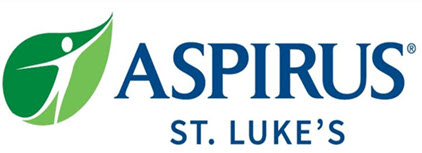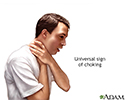Blockage of upper airway
Airway obstruction - acute upperBlockage of the upper airway occurs when the upper breathing passages become narrowed or blocked, making it hard to breathe. Areas in the upper airway that can be affected are the windpipe (trachea), voice box (larynx), or throat (pharynx).
Causes
The airway can become narrowed or blocked due to many causes, including:
-
Allergic reactions in which swelling of the trachea or throat in response to bee sting, peanuts, and tree nuts, or medicines such as antibiotics (such as penicillin), and ACE inhibitors (a medicine to treat high blood pressure)
Allergic reactions
Allergic reactions are sensitivities to substances called allergens that come into contact with the skin, nose, eyes, respiratory tract, and gastroin...
 ImageRead Article Now Book Mark Article
ImageRead Article Now Book Mark Article -
Chemical burns and reactions
Chemical burns
Chemicals that touch skin can lead to a reaction on the skin, throughout the body, or both.
 ImageRead Article Now Book Mark Article
ImageRead Article Now Book Mark Article -
Epiglottitis (infection of the structure separating the trachea from the esophagus)
Epiglottitis
Epiglottitis is inflammation of the epiglottis. This is the tissue-lined cartilage that covers the trachea (windpipe) while swallowing. Epiglottiti...
 ImageRead Article Now Book Mark Article
ImageRead Article Now Book Mark Article - Fire or burns from breathing in smoke
- Foreign bodies, such as peanuts and other breathed-in foods, pieces of a balloon, buttons, coins, and small toys
- Infections of the upper airway area
- Injury to the upper airway area
-
Peritonsillar abscess (collection of infected material near the tonsils)
Peritonsillar abscess
Peritonsillar abscess is a collection of infected material in the area around the tonsils.
 ImageRead Article Now Book Mark Article
ImageRead Article Now Book Mark Article - Poisoning from certain substances, such as strychnine
-
Retropharyngeal abscess (collection of infected material in the back of the airway)
Retropharyngeal abscess
Retropharyngeal abscess is a collection of pus in the tissues in the back of the throat. It can be a life-threatening medical condition.
 ImageRead Article Now Book Mark Article
ImageRead Article Now Book Mark Article - Severe asthma attack
Asthma attack
If you do not know whether or not you have asthma, these 4 symptoms could be signs that you do:Coughing during the day or coughing that may wake you ...
Read Article Now Book Mark Article -
Throat cancer
Throat cancer
Throat cancer is cancer of the vocal cords, larynx (voice box), pharynx, or other areas of the throat.
 ImageRead Article Now Book Mark Article
ImageRead Article Now Book Mark Article -
Tracheomalacia (weakness of the cartilage that supports the trachea)
Tracheomalacia
Acquired tracheomalacia is a weakness and floppiness of the walls of the windpipe (trachea, or airway). It develops after birth. Congenital tracheom...
 ImageRead Article Now Book Mark Article
ImageRead Article Now Book Mark Article - Vocal cord problems
- Passing out or being unconscious
People at higher risk for airway obstruction include those who have:
- Neurologic problems such as swallowing difficulty after a stroke or head injury
- Lost teeth
- Certain mental health problems
Young children and older adults are also at higher risk for airway obstruction.
Symptoms
Symptoms vary, depending on the cause. But some symptoms are common to all types of airway blockage. These include:
-
Agitation or fidgeting
Agitation
Agitation is an unpleasant state of extreme arousal. An agitated person may feel stirred up, excited, tense, confused, or irritable.
Read Article Now Book Mark Article - Bluish color of the skin (cyanosis)
Cyanosis
A bluish color to the skin or mucous membrane is usually due to a lack of oxygen in the blood. The medical term is cyanosis.
 ImageRead Article Now Book Mark Article
ImageRead Article Now Book Mark Article -
Changes in consciousness
Changes in consciousness
Decreased alertness is a state of reduced awareness and is often a serious condition. A coma is the most severe state of decreased alertness from whi...
Read Article Now Book Mark Article -
Choking
Choking
Choking is when someone is having a very hard time breathing because food, a toy, or other object is blocking the throat or windpipe (airway). A cho...
 ImageRead Article Now Book Mark Article
ImageRead Article Now Book Mark Article - Confusion
-
Difficulty breathing, gasping for air, leading to panic
Difficulty breathing
Breathing difficulty may involve:Difficult breathing Uncomfortable breathingFeeling like you are not getting enough air
 ImageRead Article Now Book Mark Article
ImageRead Article Now Book Mark Article -
Unconsciousness (lack of responsiveness)
Unconsciousness
Unconsciousness is when a person is unable to respond to people and activities. Doctors often call this a coma or being in a comatose state. Other c...
 ImageRead Article Now Book Mark Article
ImageRead Article Now Book Mark Article -
Wheezing, crowing, whistling, or other unusual breathing noises indicating breathing difficulty
Wheezing
Wheezing is a high-pitched whistling sound during breathing. It occurs when air moves through narrowed breathing tubes in the lungs.
 ImageRead Article Now Book Mark Article
ImageRead Article Now Book Mark Article
Exams and Tests
The health care provider will do a physical examination and check the airway. The provider will also ask about the possible cause of the blockage.
Tests are usually not necessary, but may include:
-
Bronchoscopy (tube through the mouth into the trachea and bronchial tubes)
Bronchoscopy
Bronchoscopy is a test to view the airways and diagnose lung disease. It may also be used during the treatment of some lung conditions.
 ImageRead Article Now Book Mark Article
ImageRead Article Now Book Mark Article - Laryngoscopy (tube through the mouth into the back of the throat and voicebox)
- X-rays or CT scan (computerized tomography)
Treatment
Treatment depends on the cause of the blockage.
- Objects stuck in the airway may be removed with special instruments.
- A tube may be inserted into the airway (endotracheal tube) to help with breathing.
Endotracheal tube
Endotracheal intubation is a medical procedure in which a tube is placed into the windpipe (trachea) through the mouth or nose. In most emergency si...
 ImageRead Article Now Book Mark Article
ImageRead Article Now Book Mark Article - Sometimes an opening is made through the neck into the airway (tracheostomy or cricothyrotomy).
Tracheostomy
A tracheostomy is a surgical procedure to create an opening through the neck into the trachea (windpipe). A tube is most often placed through this o...
 ImageRead Article Now Book Mark Article
ImageRead Article Now Book Mark Article
If the obstruction is due to a foreign body, such as a piece of food that has been breathed in, doing abdominal thrusts, back blows, or chest compressions can save the person's life.
Abdominal thrusts
Choking is when someone is having a very hard time breathing because food, a toy, or other object is blocking the throat or windpipe (airway). A cho...

Outlook (Prognosis)
Prompt treatment is often successful. But the condition is dangerous and may be fatal, even when treated.
Possible Complications
If the obstruction is not relieved, it can cause:
- Brain damage
- Breathing failure
- Death
When to Contact a Medical Professional
Airway obstruction is often an emergency. Call 911 or the local emergency number for medical help. Follow instructions on how to help keep the person breathing until help arrives.
Prevention
Prevention depends on the cause of the upper airway obstruction.
The following methods may help prevent an obstruction:
- Eat slowly and chew food completely.
- Do not drink too much alcohol before or while eating.
- Keep small objects away from young children.
- Make sure dentures fit properly.
Learn to recognize the universal sign for inability to breathe due to a blocked airway: grabbing the neck with one or both hands. Also learn how to clear a foreign body from the airway using a method such as abdominal thrusts.
References
Driver BE, Reardon RF. Basic airway management and decision making. In: Roberts JR, Custalow CB, Thomsen TW, eds. Roberts and Hedges Clinical Procedures in Emergency Medicine and Acute Care. 7th ed. Philadelphia, PA: Elsevier; 2019:chap 3.
Goodloe JM, Soulek J. Foreign bodies. In: Walls RM, ed. Rosen's Emergency Medicine: Concepts and Clinical Practice. 10th ed. Philadelphia, PA: Elsevier; 2023:chap 51.
Rose E. Pediatric upper airway obstruction and infections. In: Walls RM, ed. Rosen's Emergency Medicine: Concepts and Clinical Practice. 10th ed. Philadelphia, PA: Elsevier; 2023:chap 162.
-
Throat anatomy - illustration
Structures of the throat include the esophagus, trachea, epiglottis and tonsils.
Throat anatomy
illustration
-
Choking - illustration
Choking is the hindrance of breathing due to an obstruction of the throat or windpipe. The Heimlich maneuver should be conducted to try to dislodge the object.
Choking
illustration
-
Respiratory system - illustration
Air is breathed in through the nasal passageways, travels through the trachea and bronchi to the lungs.
Respiratory system
illustration
-
Throat anatomy - illustration
Structures of the throat include the esophagus, trachea, epiglottis and tonsils.
Throat anatomy
illustration
-
Choking - illustration
Choking is the hindrance of breathing due to an obstruction of the throat or windpipe. The Heimlich maneuver should be conducted to try to dislodge the object.
Choking
illustration
-
Respiratory system - illustration
Air is breathed in through the nasal passageways, travels through the trachea and bronchi to the lungs.
Respiratory system
illustration
Review Date: 7/1/2023
Reviewed By: Jesse Borke, MD, CPE, FAAEM, FACEP, Attending Physician at Kaiser Permanente, Orange County, CA. Also reviewed by David C. Dugdale, MD, Medical Director, Brenda Conaway, Editorial Director, and the A.D.A.M. Editorial team.





